The automotive landscape continues to evolve, offering drivers a range of choices that blend performance, comfort, and technology. Among the most competitive segments are compact hatchbacks, with the Hyundai i30 and SEAT León standing out as popular choices in this category. In this article, we will delve deep into a detailed comparison of the 2024 Hyundai i30 and the 2024 SEAT León, focusing on technical aspects, innovations, and overall value.
Hyundai i30 vs SEAT Leon – Which car suits you better?
Two cars, one duel: Hyundai i30 meets SEAT Leon.
Which one wins in performance, efficiency and value for money? Find out now!
Design and Dimensions
Both the Hyundai i30 and SEAT León present sleek, modern designs that appeal to a variety of drivers. The i30 measures 4,340 mm in length, 1,795 mm in width, and 1,455 mm in height, providing a compact yet spacious interior. In contrast, the León is slightly longer at 4,368 mm, with a width of 1,799 mm and a height range from 1,442 to 1,460 mm, depending on the variant. This subtle difference in dimensions might influence the overall cabin space and trunk capacity, where the i30 offers a commendable 395 liters compared to the León's 380 liters in its smaller configuration.
Engine Options and Performance
Under the hood, the Hyundai i30 showcases a variety of engines, ranging from a 1.0-liter 3-cylinder to a 1.5-liter 4-cylinder option, producing between 100 and 140 horsepower. With fuel consumption figures of 5.6 to 5.9 L/100km, it boasts efficiency that aligns with modern driving needs. The SEAT León, on the other hand, takes performance to another level by offering a broader range of engine choices, including petrol, diesel, and even a plug-in hybrid variant. Its petrol engines deliver between 110 and 150 horsepower, while the performance-oriented 272-horsepower hybrid variant is designed for those seeking thrilling acceleration. Notably, the León's fuel consumption is competitive, ranging from 4.5 to 5.7 L/100km.
Transmission and Handling
Both vehicles feature a choice of manual and dual-clutch automatic transmissions, tailored to enhance driving experience and efficiency. The i30 offers a smooth, user-friendly manual gearbox alongside a responsive dual-clutch option, catering to varied driver preferences. The León, however, sets itself apart with its advanced dual-clutch automatic transmission, known for quick gear changes and increased responsiveness. The i30 accelerates from 0-100 km/h in as quick as 9.6 seconds, while the León excels with figures as low as 7.7 seconds, reflecting its performance capabilities.
Innovative Features and Technologies
Innovation plays a significant role in the appeal of both models. The Hyundai i30 comes equipped with a suite of safety and tech features, including a touchscreen infotainment system, smartphone connectivity, and advanced driver-assistance systems. Meanwhile, the SEAT León also embraces modernity with its intuitive infotainment setup, virtual cockpit, and seamless smartphone integration, alongside competitive driver-assistance technologies that enhance safety. An exciting aspect of the León is its optional plug-in hybrid variant that boasts an impressive electric range of up to 133 km, a critical consideration for eco-conscious drivers.
Cost of Ownership and Overall Value
In terms of pricing, the Hyundai i30 generally presents a more affordable entry point compared to the SEAT León, appealing to budget-conscious consumers. However, the added technology and performance options in the León may justify the higher price tag for those seeking advanced features. Maintenance costs for both vehicles fall within similar ranges, with neither brand significantly surpassing the other in terms of reliability ratings.
Conclusion: Which One to Choose?
Ultimately, the choice between the Hyundai i30 and SEAT León boils down to personal preference and driving needs. The i30 appeals with its value for money and a solid set of features, while the León stands out with its extensive engine range and advanced technological offerings. Both cars are excellent representatives of the hatchback segment, catering to drivers who value performance, comfort, and innovation. As always, prospective buyers should consider test-driving both models to find the ideal match for their lifestyle.
Here’s where it gets real: The technical differences in detail
Costs and Efficiency:
Price and efficiency are often the first things buyers look at. Here it becomes clear which model has the long-term edge – whether at the pump, the plug, or in purchase price.
Hyundai i30 has a hardly perceptible advantage in terms of price – it starts at 24000 £, while the SEAT Leon costs 24500 £. That’s a price difference of around 463 £.
Fuel consumption also shows a difference: SEAT Leon manages with 0.30 L and is therefore clearly more efficient than the Hyundai i30 with 5.70 L. The difference is about 5.40 L per 100 km.
Engine and Performance:
Power, torque and acceleration say a lot about how a car feels on the road. This is where you see which model delivers more driving dynamics.
When it comes to engine power, the SEAT Leon has a clearly edge – offering 272 HP compared to 140 HP. That’s roughly 132 HP more horsepower.
In acceleration from 0 to 100 km/h, the SEAT Leon is distinct quicker – completing the sprint in 7.70 s, while the Hyundai i30 takes 9.60 s. That’s about 1.90 s faster.
In terms of top speed, the SEAT Leon performs to a small extent better – reaching 220 km/h, while the Hyundai i30 tops out at 197 km/h. The difference is around 23 km/h.
There’s also a difference in torque: SEAT Leon pulls evident stronger with 360 Nm compared to 253 Nm. That’s about 107 Nm difference.
Space and Everyday Use:
Beyond pure performance, interior space and usability matter most in daily life. This is where you see which car is more practical and versatile.
Both vehicles offer seating for 5 people.
In curb weight, Hyundai i30 is hardly perceptible lighter – 1291 kg compared to 1344 kg. The difference is around 53 kg.
In terms of boot space, the Hyundai i30 offers slight more room – 395 L compared to 380 L. That’s a difference of about 15 L.
Maximum load volume is the same – both hold up to 1301 L.
When it comes to payload, SEAT Leon hardly perceptible takes the win – 521 kg compared to 509 kg. That’s a difference of about 12 kg.
Who comes out on top?
Overall, the SEAT Leon shows itself to be wins the duel decisively and secures the title of DriveDuel Champion.
It convinces with the more balanced overall package and proves to be the more versatile choice for everyday use.
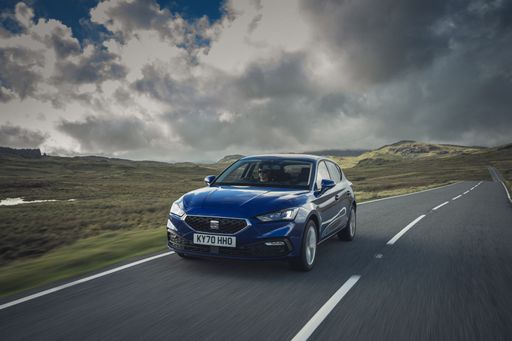
SEAT Leon
Hyundai i30
The Hyundai i30 stands out in the hatchback segment with its sleek design and modern features. It offers a comfortable ride with a well-crafted interior that caters to both driver and passengers. With its emphasis on safety and technology, the i30 provides a balanced driving experience suitable for urban and suburban environments.
details @ hyundai.news
@ hyundai.news
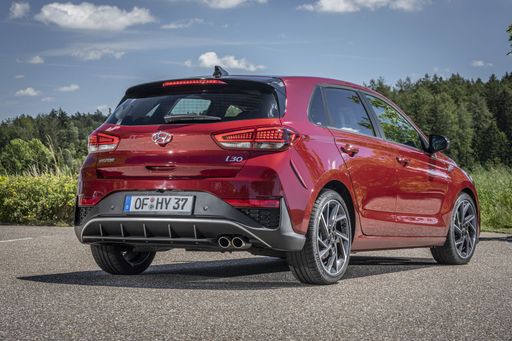 @ hyundai.news
@ hyundai.news
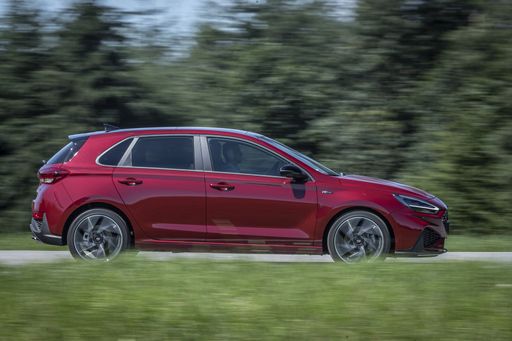 @ hyundai.news
@ hyundai.news
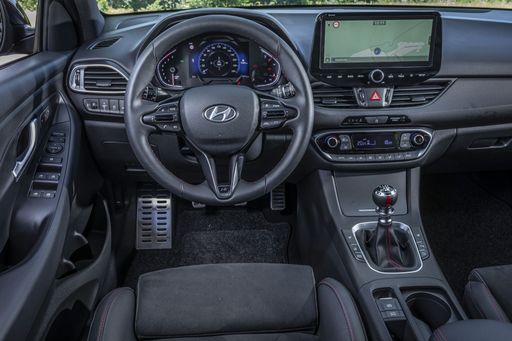 @ hyundai.news
@ hyundai.news
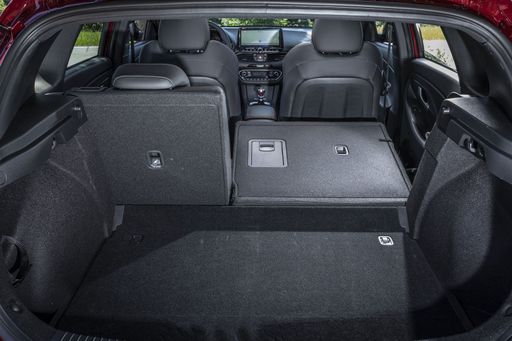 @ hyundai.news
@ hyundai.news
SEAT Leon
The SEAT Leon impresses with its dynamic design and sporty edge, making it a standout choice in its class. Its interior is characterised by a modern, driver-focused cockpit that combines functionality with an emphasis on comfort. The car delivers a responsive driving experience, thanks to its advanced engineering and agile handling capabilities.
details @ seatmedia
@ seatmedia
 @ seatmedia
@ seatmedia
 @ seatmedia
@ seatmedia
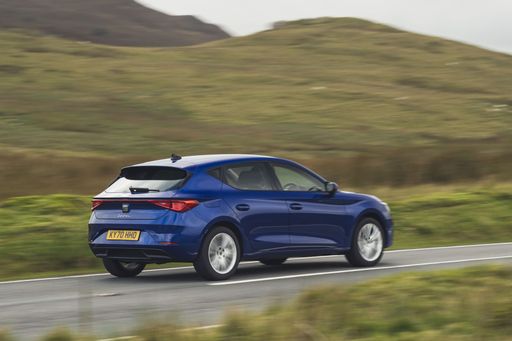 @ seatmedia
@ seatmedia

|

|
|
|
|
Costs and Consumption |
|
|---|---|
|
Price
24000 - 29300 £
|
Price
24500 - 36400 £
|
|
Consumption L/100km
5.7 - 6 L
|
Consumption L/100km
0.3 - 5.7 L
|
|
Consumption kWh/100km
-
|
Consumption kWh/100km
-
|
|
Electric Range
-
|
Electric Range
133 - 134 km
|
|
Battery Capacity
-
|
Battery Capacity
19.70 kWh
|
|
co2
130 - 136 g/km
|
co2
7 - 129 g/km
|
|
Fuel tank capacity
50 L
|
Fuel tank capacity
40 - 45 L
|
Dimensions and Body |
|
|---|---|
|
Body Type
Hatchback
|
Body Type
Hatchback
|
|
Seats
5
|
Seats
5
|
|
Doors
5
|
Doors
5
|
|
Curb weight
1291 - 1407 kg
|
Curb weight
1344 - 1670 kg
|
|
Trunk capacity
395 L
|
Trunk capacity
270 - 380 L
|
|
Length
4340 mm
|
Length
4368 mm
|
|
Width
1795 mm
|
Width
1799 mm
|
|
Height
1455 mm
|
Height
1442 - 1460 mm
|
|
Max trunk capacity
1301 L
|
Max trunk capacity
1187 - 1301 L
|
|
Payload
463 - 509 kg
|
Payload
460 - 521 kg
|
Engine and Performance |
|
|---|---|
|
Engine Type
Petrol, Petrol MHEV
|
Engine Type
Petrol, Petrol MHEV, Diesel, Plugin Hybrid
|
|
Transmission
Manuel, Automatic
|
Transmission
Manuel, Automatic
|
|
Transmission Detail
Manual Gearbox, Dual-Clutch Automatic
|
Transmission Detail
Manual Gearbox, Dual-Clutch Automatic
|
|
Drive Type
Front-Wheel Drive
|
Drive Type
Front-Wheel Drive
|
|
Power HP
100 - 140 HP
|
Power HP
110 - 272 HP
|
|
Acceleration 0-100km/h
9.6 - 13.1 s
|
Acceleration 0-100km/h
7.7 - 10.5 s
|
|
Max Speed
178 - 197 km/h
|
Max Speed
197 - 220 km/h
|
|
Torque
172 - 253 Nm
|
Torque
220 - 360 Nm
|
|
Number of Cylinders
3 - 4
|
Number of Cylinders
4
|
|
Power kW
74 - 103 kW
|
Power kW
85 - 200 kW
|
|
Engine capacity
998 - 1482 cm3
|
Engine capacity
1498 - 1968 cm3
|
General |
|
|---|---|
|
Model Year
2024
|
Model Year
2024 - 2025
|
|
CO2 Efficiency Class
D, E
|
CO2 Efficiency Class
D, B
|
|
Brand
Hyundai
|
Brand
SEAT
|
What drive types are available for the Hyundai i30?
Available configurations include Front-Wheel Drive.
The prices and data displayed are estimates based on German list prices and may vary by country. This information is not legally binding.
